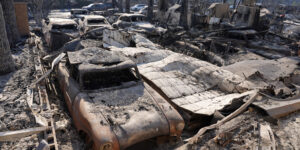Wineries and hospitality businesses in and around Napa, California, near the epicenter of the worst earthquake to hit the area in 25 years, rushed to clean up rubble and broken glass ahead of the expected influx of tourists for a drought-accelerated grape harvest.
“We are right in the thick of it,” said Steve Matthiasson, a Napa-based grape grower and vintner who produces wine under the Matthiasson label. “It could not be a worse time” for a quake.
The temblor, 6.0 magnitude on the Richter scale, struck the California wine country Aug. 24 about 60 miles (97 kilometers) north of San Francisco. It could lead to economic losses of as much as $4 billion from wrecked wine stock and shuttered businesses that rely on tourists, according to an estimate from Kinetic Analysis Corp.
The earthquake crumpled parts of historic buildings, cracked roads and injured more than 200 people. Structural damage was concentrated in the city of Napa, especially in the downtown area, and the wineries, hotels, restaurants and other businesses nearby. Still, some tasting rooms were open just hours after the earthquake.
“Everybody can get back to business here pretty quick, once we stop jumping every time we hear a door slam or a roof creak,” said Rob McMillan, executive vice president and founder of Silicon Valley Bank’s wine division. “The businesses here are really looking forward to hosting people.”
Early Harvest
The earthquake came as the Napa-Sonoma area has been forced to speed up the grape harvest amid a worsening drought that has gripped the state for three years. The harvest under way now is usually in September, traditionally the industry’s busiest time and a peak period for visitors.
“You have people from the San Francisco Bay area that might not come up, but the roads are open and with the exception of a few areas that are cordoned off, it really isn’t a problem getting up and down the valley,” said Michael Honig, owner of Honig Vineyard & Winery and a board member of Napa Valley Vintners, a trade association. “The people who are coming in on airplanes or from a distance I don’t think are going to change their plans.”
Domaine Carneros, with a Napa Valley-based chateau surrounded by rolling hills dotted with vineyards, was seeing about half its normal rate of tourist visits yesterday, said Eileen Crane, chief executive officer and founding winemaker.
‘Staying Away’
“Right now, people are staying away,” she said. “A lot of the wineries are closed.”
Crane said she expects the flow of visitors to rebound quickly. “By Sept. 15, we’ll be at about 90 to 95 percent,” she said. “Why wouldn’t you want to come here?”
Bill Price, chairman of Sonoma-based Vincraft Group and co- founder of buyout firm TPG Capital, said two of his wine brands, Three Sticks and Kistler Vineyards, have tasting rooms in Sonoma County and could be harmed by a drop in tourism.
“Both of those rely on visitors for a lot of their business,” said Price, who is owner or part owner of seven wineries in Napa, Sonoma and Santa Barbara. “I’m afraid that the perception from the outside, that it would discourage people from coming to Napa or Sonoma.”
Bistro Don Giovanni in Napa lost about a third of its wine and liquor inventory, worth $20,000 to $30,000, said Curtis Bradford, the restaurant’s manager.
“Everything behind the bar was on the floor as far as liquor,” he said. “The refrigerators all opened up and emptied out. China from where we store the china in the dining room was on the floor.”
Cleanup Effort
The cleanup effort also extended to boutique hotels, spas and shops across town as they prepare for the upcoming three-day Labor Day holiday weekend.
Napa County had 789 licensed wineries with combined sales of $5.5 billion in 2011, according to theNapa Valley Vintners. Some wineries, mostly in the city of Napa and immediate surrounding areas, sustained significant damage to barreling storage, wine inventories and production equipment, according to the Napa Valley Vintners.
“People are starting to clean up and get on with the business of harvest,” Cate Conniff, a spokeswoman for the vintners, said in a telephone interview. “There’s a strong spirit of collaboration here. If someone’s missing a fermenter, someone’s going to get it to them.”
U.S. Agriculture Secretary Tom Vilsack said yesterday in Arlington, Virginia, that it was too early to make any disaster declaration that would give affected wine growers eligibility for special loans and assistance.
Loma Prieta
The temblor was the strongest in the Bay Area since the 6.9 Loma Prieta earthquake that rocked San Francisco in October 1989.
Insurers will probably cover about $2.1 billion in damage, according to Kinetic Analysis. Costs borne by the insurance industry may be limited because many homeowners don’t have earthquake coverage, according to the Insurance Information Institute.
Catastrophe-modeler Eqecat Inc. estimated there would be $1 billion of insured losses, with as much as half that figure coming from residential claims. The cost for insurers could climb because of coverage that protects commercial policyholders from lost revenue, Eqecat said. Such losses have fueled higher- than-expected claims from other catastrophes including superstorm Sandy in 2012.
Even winemakers with damage will need to turn their attention to the grape harvest, because the crop must be picked at exactly the right time.
“During harvest, you work 14 hours a day, seven days a week,” said Steve Matthiasson. “There’s no spare time. We have to pick our grapes.”
–With assistance from Alan Bjerga in Washington, Lydia Mulvany and Megan Durisin in Chicago and Zachary Tracer in New York.





















 Sentry Transformation Saves ‘Tens of Thousands of Hours’ With AI in Claims
Sentry Transformation Saves ‘Tens of Thousands of Hours’ With AI in Claims  Why the LA Wildfires Should Not Have Been a Surprise Loss
Why the LA Wildfires Should Not Have Been a Surprise Loss  Bringing Positive Vibes Back to Personal Lines Insurance
Bringing Positive Vibes Back to Personal Lines Insurance  Enterprise Risk Management Secrets for Long-Term Company Growth
Enterprise Risk Management Secrets for Long-Term Company Growth 



